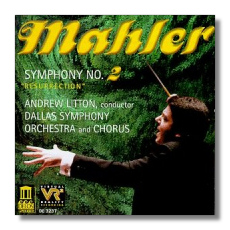
The Internet's Premier Classical Music Source
Related Links
- Mahler Reviews
- Latest Reviews
- More Reviews
-
By Composer
-
Collections
DVD & Blu-ray
Books
Concert Reviews
Articles/Interviews
Software
Audio
Search Amazon
Recommended Links
Site News
 CD Review
CD Review
This release initiates Delos's Mahler symphony cycle in Dallas (Symphony #3 is slated for release later this year), and it's really something to be proud of; this "Resurrection" can compete with any digital recording currently on the market. The interpretation and musicianship are first-class, and engineer John Eargle's Virtual Reality Recording (VR2) will have audiophiles talking. Certainly there are few classical works more appropriate for this technique than Mahler's Second.
Litton's stature as a conductor continues to grow, and now he is ready for this challenge. His outgoing "Resurrection," while powerfully dramatic, is largely free from excess and egregious "interpretation." All of his tempos are well judged. I particularly appreciated his "Urlicht," which, at 4:57, is more than a minute shorter than Bernstein's London version. The quicker tempos emphasize the movement's bittersweet melody, but the same really could be said of the entire symphony, which seems unusually songful under Litton's gentle persuasion. The opening funeral march is more angry than mournful; listen to how Litton underscores the repeated harsh and dissonant chords that usher in the movement's recapitulation. The third movement bites too; Litton does not lose its implied message. (The movement is based on Mahler's Wunderhorn song describing Saint Anthony's sermon to the fishes, which, while heard, goes unheeded by them.) In between, the second movement is an oasis of only slightly decayed nostalgia, and Litton lets its sentimentality speak for itself.
The finale must seem like the logical conclusion to all that has come before. Particularly on disc, it can seem episodic – no more than a series of heart-stopping effects. Fortunately, Litton's intensity is the glue that holds the music together, and the big spiritual climax is genuinely moving; it could make a believer out of the most hardened atheist.
Murphy and Lang are the appealing and very human soloists; the latter's youthful vocal presence is a plus in "Urlicht," which never benefits from a matronly mezzo! The chorus, apparently quite large, is passionate but disciplined. The booklet lists the complete orchestral personnel. This is only fitting, given the high level of their achievement. Dallas has a fine brass section, and the "Resurrection" Symphony gives them the spotlight.
Eargle's recording hides nothing; I even heard the organ clearly. And even in the absence of Dolby Pro-Logic surround sound playback, I was impressed by the soundstaging. Furthermore, here's proof that exquisite detailing of a full orchestral sound can be done without creating a feel of artificiality. Turn up the volume and be amazed!
In short, while I am not about to throw out versions by Bernstein, Sinopoli, Klemperer, Stokowski, and others, this "Resurrection" can be recommended to anyone who wants a superb performance of this score, and in premium sound to boot.
Copyright © 1999, Raymond Tuttle



















